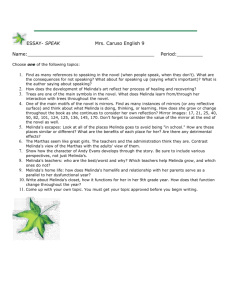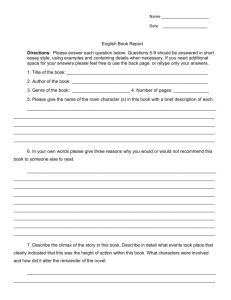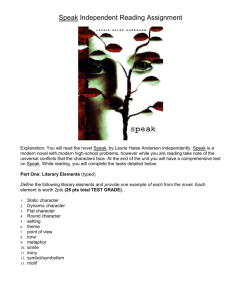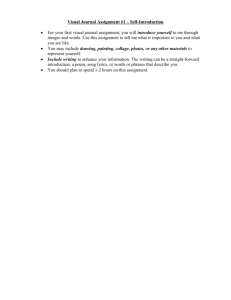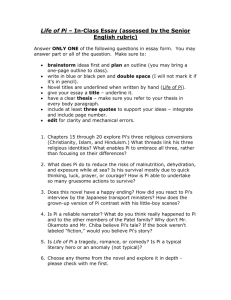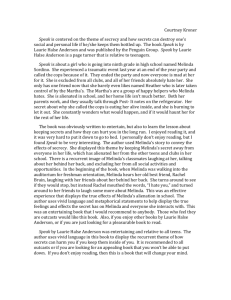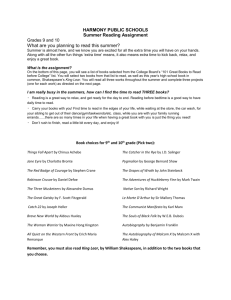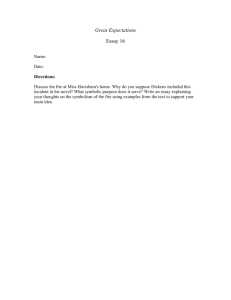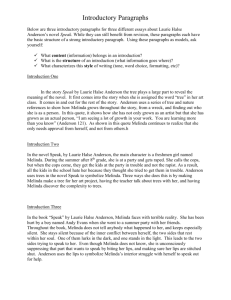File
advertisement
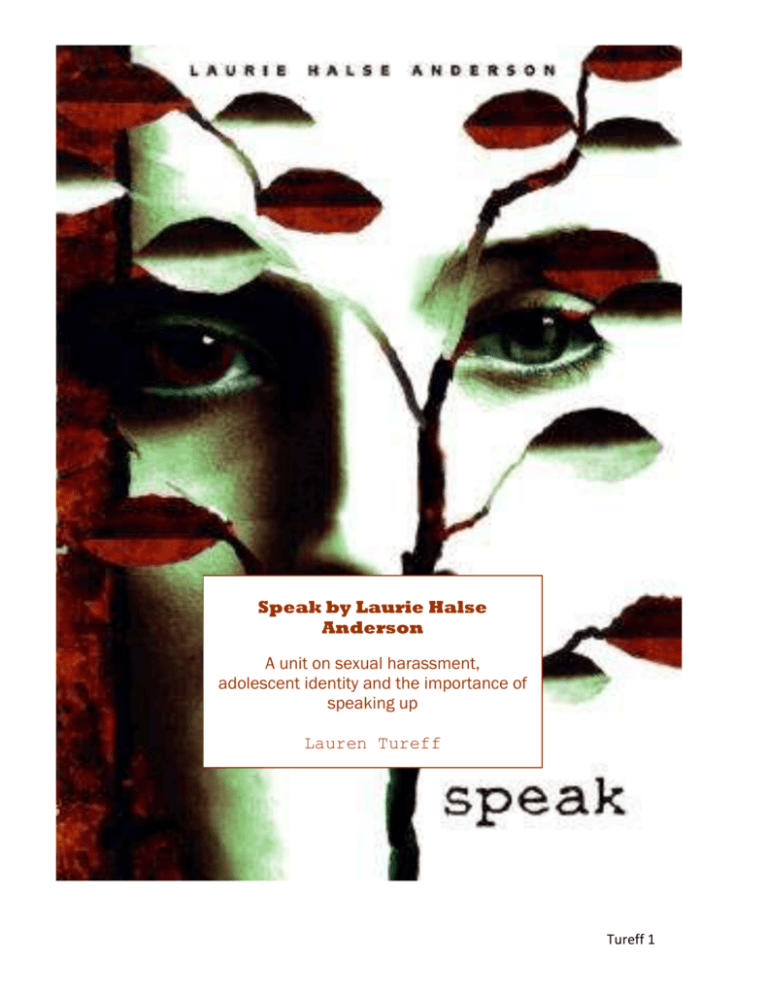
Speak by Laurie Halse Anderson A unit on sexual harassment, adolescent identity and the importance of speaking up Lauren Tureff Tureff 1 Lauren Tureff ENG4790 April 10, 2011 Speak by Laurie Halse Anderson A unit on sexual harassment, adolescent identity and the importance of speaking up Grade Level: 9-12 Time Frame: 3 weeks/15 days--60 minute periods Unit Overview: Speak by Laurie Halse Anderson (1999) is a novel told through the voice of a teenage girl, Melinda Sordino as she experiences her freshmen year of high school. Melinda is your average teenage girl- humorous yet serious, dark yet vivid and insecure yet inquisitive. The summer before freshmen year, Melinda attended a party in which something occurred and she called the cops. At the beginning of the story, it is unclear as to why Melinda chooses not to speak and her behavior is extremely introverted. Instead of blending in, making lots of friends and enjoying high school, Melinda withdraws and secludes herself from the other students. She hides from the world, remains silent and avoids interaction. Many teenagers, especially those just entering high school can relate to Melinda-the way she feels, behaves, reacts and thinks about certain groups, stereotypes, teachers and school in general. This book also touches on serious subjects such as date rape and teenage depression. It addresses these issues in an appropriate and sensitive way that allows students to gain an awareness regarding these issues in a manner that will not make them uncomfortable or uneasy. Melinda Sordino is a believable character living in a believable story. This story also addresses the importance of individuals speaking up, stating their opinions and using their voices. Being the fact that many can relate to this character and can easily read and understand the language and form it is written in, this story will reach a vast amount of students easily and deeper lessons can be learned. Theory to Practice: This unit incorporates three different major assignments that students will accomplish in order to demonstrate their understanding of the novel, the essential topics presented in the novel as well as improve and strengthen their writing skills. Students will exhibit their understandings and improvement through the practice of the writing process (brainstorming, drafting, editing, peer editing, revising, and the final draft). Students are all unique and learn differently and having a variety of assignments that allows for creativity and individual expression will better reach and suit different student learners. The first project that students will work on throughout the course of the unit invites students to speak and express themselves through the Tureff 2 medium of their choice without actually “talking”. The other two major assignments invite students to strengthen their writing skills. There is a longer essay due at the completion of the unit where the students are given a multitude of choices to respond to regarding the overall novel in order to demonstrate their understanding and comprehension of the novel. The unit activity provides a variety of different options as well in which students will dissect a portion of the novel and further analyze it. By providing different choices and options that students can choose from, students are able to use creativity, are free to express themselves and strengthen their writing skills through the practice of different genres. This unit incorporates ideas from the book Micro Lessons in Writing by Jim Vopat. Student Objectives: Throughout the course of this unit, the following student objectives will be met: Students will understand that there are many other ways to speak besides actually talking such as nonverbal behaviors, body language, etc and demonstrate this fact through the presentation of their chosen art medium. Students will be able to practice appropriate classroom discussion and interaction with peers by contributing their thoughts and understanding of the reading. After reading and discussing the assigned reading, students will have a better grasp of the different characters and will be able to demonstrate their understanding of which characters demonstrate behaviors accepted by society and which portray behaviors that are not seen as the norm of society through involvement in a class discussion. Students will learn an assortment of pre-reading and previewing strategies they can use and will demonstrate their understanding of these strategies by implementing them in their daily reading. Given a poem relating to the novel, students will be able to analyze, compare and contrast the two pieces of literature with the use of organizational columns. Students will implement the assortment of pre-reading and previewing strategies they have learned and will demonstrate their understanding of these strategies by comprehending the poem and analyzing the piece. Working in small groups students will research a specific topic individually and with peers and demonstrate their findings by presenting orally and in written form The students will gain a better understanding and awareness of sexual assault through learning and discussing sexual assault statistics Given facts and statistics, students will be able to absorb the information and conclude and present their own thoughts, opinions Tureff 3 and feelings as well as attempt to convince others of their argument regarding the specified topic in a group discussion. Working with fellow peers, students will practice and improve their peer editing skills by reading and editing two other essays written by their peers. Students will further progress and develop editing skills and implement their previewing, reading and listening strategies by editing a peer’s essay and responding appropriately both verbally and in written form. Students will discover the ways that prior knowledge and personal growth and experience affect their interpretation of their art projects by presenting their projects to the class. Resources: copies of the book Speak by Laurie Halse Anderson, access to library— books, computer, internet, writing utensils, notebook/paper, presentation supplies--glue, scissors, poster/large paper, markers, crayons. Teacher Preparation: journal entry prompts need to be written on board before students enter the classroom. Library or computer access needs to be planned for the third (final) week of the unit. Copies of the following materials need to be done based on the class size: Anticipatory guide, 1st, 2nd, 3rd and 4th marking period study guides, poetry column/comparison worksheet, song lyrics, test, rubrics, assignment sheets and “Know the Facts” quiz. Michigan Content Standards and Expectations: Throughout this unit, I have incorporated the usage of 24 different Michigan Benchmarks. Several of these benchmarks are used numerous times throughout this unit for they pertain to the daily lesson or assignments. The list is as follows: CE 1.1.1: Demonstrate flexibility in using independent and collaborative strategies for planning, drafting, revising and editing complex texts. CE 1.1.5: Revise drafts to more fully and or precisely convey meaning-drawing on response from others, self-reflection and reading one’s own work with the eye of a reader; then refine the text-deleting and or reorganizing ideas and addressing potential readers’ questions. CE 1.1.7: Edit for style, tone and word choice and for conventions of grammar, usage and mechanics that are appropriate for audience. CE 1.1.8: Proofread to check spelling, layout and font; and prepare selected pieces for a public audience. CE 1.2.2: Write, speak and visually represent to develop self-awareness and insight. CE 1.2.3: Write, speak and create artistic representations to express personal experience and perspective. Tureff 4 CE1.3.1: Compose written, spoken and or multimedia compositions in a range of genres: pieces that serve a variety of purposes and that use a variety of organizational patterns. CE 1.3.4: Develop and extend a thesis, argument or exploration of a topic by analyzing differing perspectives and employing a structure that effectively conveys the ideas in writing. CE 1.3.6: Use speaking, writing and visual presentations to appeal to audiences in different social, economic and cultural backgrounds and experiences. CE 1.3.7: Participate collaboratively and productively in groups fulfilling roles and responsibilities, posing relevant questions, giving and following instructions, acknowledging and building on ideas and contributions of others to answer questions or to solve problems and offering dissent courteously. CE 1.3.8: Evaluate own and others’ effectiveness in group discussions and formal presentations. CE 2.1.1: Use a variety of pre-reading and previewing strategies to make conscious choices about how to approach the reading based on purpose, genre, level of difficulty, text demands and features. CE 2.1.7: Demonstrate understanding of written, spoken or visual information by restating, paraphrasing, summarizing, critiquing or composing a personal response; distinguish between a summary and a critique. CE 2.1.8: Recognize the conventions of visual and multimedia presentations and how they carry or influence messages. CE 2.1.9: Examine the intersections and distinctions between visual and verbal communication. CE 2.1.11: Demonstrate appropriate social skills of audience, group discussion, or work team behavior by listening attentively and with civility to the ideas of others, gaining the floor in respectful ways, posing appropriate questions and tolerating ambiguity and lack of consensus. CE 2.1.12: Use a variety of strategies to enhance listening comprehension. CE 2.2.2: Examine the ways in which prior knowledge and personal experience affect the understanding of written, spoken or multimedia text. CE 2.3.4: Critically interpret primary and secondary research-related documents. CE 3.1.1: Interpret literary language while reading literary and expository works. CE 3.1.5: Comparatively analyze two or more literary or expository texts comparing how and why similar themes are treated differently, by different authors, in different types of text, in different historical periods, or from different cultural perspectives. CE 3.1.6: Examine differing and diverse interpretations of literary works and explain how and why interpretation may vary from reader to reader. CE 3.1.7: Analyze and evaluate the portrayal of various groups, societies and cultures in literature and other texts. CE 3.1.8: Demonstrate an understanding of historical, political, cultural and philosophical themes and questions raised by literary and expository works. CE 3.1.9: Analyze how the tensions among characters, communities, themes and issues in literature and other texts reflect human experience. Tureff 5 Explanation of pre-reading, during-reading and after-reading writings (can be found within the lesson plan procedures) Pre-reading- After being given song lyrics that pertain to the book and viewing the cover of the novel, students will write down their ideas, key words, thoughts and predictions about the book. Students will also write in a journal at the beginning of every class period. During-reading- Students will continue to write in their journals. Students will also write song lyrics, poetry, rewriting scenes, short reflections and summaries. After-reading- Students will write a multitude of pieces and reflections that demonstrate their comprehension and understanding of the novel. Students will write an essay regarding the novel as a whole, analyze a specific idea or section of the text through the genre of their choice and write a paper summarizing, comparing and contrasting the book to the movie. Daily Lesson Plans: Lesson Plan Procedure Day 1: Estimated time 15 minutes 10 minutes 10 minutes 15 minutes: Activity/procedure 1. Pass out to each student in the class poems and song lyrics that relate to the book. 2. Have the students volunteer to read them aloud while other students follow along. 3. (Pre-reading) Ask the students what they believe the book will be about based on the words/emotions/language/descriptions etc. exemplified in the examples they just read. 4.(Pre-reading Writing) Have the students write down their ideas/key words/predictions individually and then on the board as a class. 1. Pass out the book Speak and have students continue to voice their predictions based on the cover art of the book and by skimming through the book. 2. Give the students a brief synopsis of the book and the author. 3. Explain to the students how this book may relate to many adolescents. 1. Put on overhead projector the list of “The first 10 Lies They Tell You In High School” and read them aloud to the class. 2. Lead class discussion asking: Are they all lies? If so, why do they tell them to high school freshman? Can you relate to this? Which one stands out to you the most? 1. Briefly list off the projects, assignments, activities and what is Tureff 6 5 minutes: expected of them throughout this unit. 2. Have the students divide into groups of 3 or 4. 3. Give each group a large piece of paper and a basket of markers. 4. Have the students begin to create their own list of 10 lies that either they were told or believe are lies regarding high school. 5. When they are finished, have them hang their 10 lies on the wall for all the other students to read. 6. End class with a mini discussion comparing and contrasting their peers 10 lies. (this activity Is to allow the students to relate/compare to the characters in the book) Assign homework: Read pages 1-18. Day 1 Materials: THE FIRST 10 LIES THEY TELL YOU IN HIGH SCHOOL 1. We are here to help you 2. You will have enough time to get to your class before the bell rings. 3. The dress code will be enforced. 4. No smoking is allowed on school grounds. 5. Our football team will win the championship this year. 6. We expect more of you here. 7. Guidance counselors are always available to listen. 8. Your schedule was created with your needs in mind. 9. Your locker combination is private. 10. These will be the years you look back on fondly. Song Lyrics: SCARED OF LONELY” by Beyonce Tureff 7 (not entire song) I'm in this fight and I'm swinging and my arms are getting tired I'm trying to beat this emptiness but I'm running out of time I'm sinking in the sand and I can't barely stand I'm lost in this dream, I need you to hold me I'm scared of lonely I try to be patient but I'm hurting deep inside And I can't keep waiting, I need comfort late at night And I can't find my way, won't you lead me home? 'Cause I'm lost in this dream, I need you to hold me I'm scared of lonely And I'm scared of being the only shadow I see along a wall And I'm scared of the only heart beat I hear beating is my own And I'm scared of being alone, I can't seem to breathe When I am lost in this dream, I need you to hold me 'Cause I'm tired of this emptiness POEM Childhood Gone - By Sherry Survivor In one day all was gone, No longer a child, No longer to play, The toys put away, The bicycle to rust away, A child gone, No way to return, A child taken, Not from home, But from life, The only one she knew, To be lied to, To be confused, A child to0 young to know, Too scared to talk, Hidden in a world where nothing made sense, A child Abused and alone, Empty and afraid, With no where to go, "Afraid" by Nelly Furtado (not entire song) What they say what they say what they say You speak out all you feel is defiance All you need is some self-reliance Tureff 8 Cause this world is gonna always try us And all you wanted was to run for cover Well here's looking to yourself and no other We're all searching for that special something And we keep on running We all have the choice to take the lead or follow You're so afraid of what people might say But that's okay cause you're only human You're so afraid of what people might say But that's okay you'll soon get strong enough You're so afraid of what people might say But that's okay cause you're only human You're so afraid of what people might say You're going to break You wanna spread your wings but you're not sure Don't wanna leave your comforts Wanna find a cure We're afraid of who we see in the mirror We wanna let go but it feels too pure Who wants to be alone in this world You look around and all you see is hurt But the light it always finds us If we move with a little trust “INNOCENT” by Taylor Swift (not entire song) Wasn't it easier in your lunchbox days? Always a bigger bed to crawl into Wasn't it beautiful when you believed in everything? And everybody believed in you? It's all right, just wait and see Oh, who you are is not where you've been You're still an innocent There's some things you can't speak of But tonight you'll live it all again You wouldn't be shattered on the floor now If only you would sing what you know now then Every one of us has messed up too Lives change like the weather I hope you remember Today is never to late to Be brand new Lesson Plan Procedure Day 2: Estimated Time Activity/procedure Tureff 9 5 minutes 20 minutes 15 minutes 15 minutes 5 minutes 1. Have students write their first journal entry discussing their predictions, ideas and thoughts regarding this new book. Explain that each journal entry must be a minimum of a ½ page. 1) Hand out Anticipatory Guide. Have students complete the first part. 2) Discuss what the student’s views and thoughts are regarding the book thus far. What are their reactions/feelings towards the main character? The style/voice the book is written in? Do the students view the main character in a positive and trustworthy or negative and apprehensive light? 1. Have each student pick a piece of paper out of a bowl just as Melinda’s art class did in the novel. Each piece of paper has one word on it-an object. 2. Explain that the students are to create an art project like they do in the book in which they will speak through their art work without literally “talking” by using clay, drawing, painting, sculpting, pastels, music etc. Students will also write a one page self reflection explaining the project in words. 3. Explain that the students should continue to work on their project outside of class and it will be due at the end of the unit where they will present their project to the class. 1. give students time to plan, and sketch ideas for their project. Have students think about what they want to “say” through the use of their art and write idea down to assess student’s thinking. Assign homework: read pages 18-32 Lesson Plan Procedure: Day 3 Begin class by having students write their second journal entry. Then, discuss as a whole class the assigned reading from the previous night. Assign homework: read pages 32-46. Complete 1st marking period study guide. Lesson Plan Procedure: Day 4 Tureff 10 Estimated Time 5 minutes 20 minutes 5 minutes Activity/Procedure 1)1st marking period study guide due. 2)Have students write their third journal entry: what are your thoughts and feelings towards “The Marthas?” How are you similar/different to them? What are their characteristics and attributes? 1. Class Discussion: “The Marthas” 2. Restate the description of the Marthas: In the novel, the group “The Marthas” depict the types of girls that society-including teachers, parents, elders etc expect ladies to be, act like, behave etc. Description of Marthas: Outfits must be coordinated, crisp, seasonally appropriate Big on helping Do philanthropy, perform good deeds. Run the canned-food drives, tutor kids in the city, host walkathons to raise money Do nice things for teachers Good grades Friendly, neat, organized, active in society No drugs, no drinking 3. Discussion question/prompt: In what ways do you conform to what is expected of you? In what ways do you rebel against what is expected of you? 1. Explain assignment activity: 2. Provide magazines, glue, large paper and scissors for students to cut out words and pictures that provide examples to answer the question previously asked. In other words, have students create a collage that represents and depicts what society expects from individuals as well as examples that would not be accepted or approved by society. 3. (during-reading) Ask students to write a short reflection or summary explaining Tureff 11 25 minutes 5 minutes their collage- 1)why did they choose the words and images they did. 2) write own personal answer regarding how do you conform to what is expected of you, and in what ways do you rebel against what is expected of you. 1. give students class time to create their collages. Homework: Finnish collage and reflection Lesson Plan Procedure Day 5: Have students write their fourth journal entry. Ask students to share and explain their collages to the class. Welcome students to ask questions, agree or disagree in a polite and respectful fashion. After presenting, give students options as to how they would like to read the next section of the book in class today. Options: small groups, on tape or as a class by round robin. Read pages 49-64 in class. Assign homework: read pages 65-92 and complete the 2nd marking period study guide. Lesson Plan Procedure Day 6: (grammar mini lesson) Give students a pile of magazines, scissors and glue. Have them look through the ads and short titles in magazines looking for fragments. For example, on a Neutrogena advertisement for shampoo, the words were, “Lots of shine,” “No fuss,” and “One thousand beautiful strands.” When they are able to find fragments in ads of popular magazines, they will be more apt to find them in their writing and the writing of their peers. Once they find the fragments, have them cut them out, glue them to paper and underneath the ad, rewrite the fragment in correct sentence formation. This will help them in editing their peers papers next week during peer review. Lesson Plan Procedure: Day 7: Estimated Time 5 minutes 20 minutes 5 minutes Activity/Procedure Have students write their sixth journal entry: what progression have you seen Melinda make from the first to second marking period? 2. Pass out quiz to students. Make sure all books and notes are put away. 1. After all students have completed the quiz, explain the poetry assignment. 2. (during-reading) Directions: Students are to read the poem a few times to themselves, then underline and highlight specific significant parts. Then they are to make notes in the second column for Tureff 12 25 minutes 5 minutes how the speaker of the poem may relate to Melinda. 3. Students are then to create their own poem, or song lyrics in which they write from the perspective of Melinda. Students may want to include how she feels, what she is thinking, what scares or intimidates her, what she enjoys or makes her feel safe etc. Poem/song lyrics must be a minimum of 15 lines. Students are to work on the poetry assignment in class. Assign Homework: Poetry Column Comparison/own personal poem/song lyrics. Read pages 95-125 Day 7 Assignment Name _______________________ Directions: (during-reading writing) Read the poem over a few times. Highlight and underline specific significant words. In the Brainstorming column, make notes to how you believe the speaker of the poem relates to Melinda in the novel Speak. When you have completed the column notes, write your own poem or song lyrics in which you write from the perspective of Melinda. You may want to include how she feels, what she is thinking, what scares or intimidates her, what she enjoys or makes her feel safe etc. Poem/song lyrics must be a minimum of 15 lines. Be creative! POEM I fight like a girl who refuses to be a victim. I fight like a girl who is tired of being IGNORED + HUMORED + BEATEN + RAPED. I fight like a girl who’s sick of not being taken seriously. I fight like a girl who’s been pushed too far. I fight like a girl who OFFERS + DEMANDS RESPECT. I fight like a girl who has a lifetime of ANGER + STRENGTH + PRIDE pent up in her girly body. I fight like a girl who doesn’t believe in FEAR + SUBMISSION. Brainstorming Notes/Comparisons Tureff 13 I fight like a girl who knows that THIS BODY + THIS MIND are mine. I fight like a girl who knows that YOU ONLY HAVE AS MUCH POWER AS I GRANT YOU. I fight like a girl who will never allow you to take more than I offer. I fight like a girl who FIGHTS BACK. So next time you think you can distract yourself from your insecurities by victimizing a girl, THINK AGAIN. She may be ME and I FIGHT LIKE A GIRL. After Silence Blog at WordPress.com. Theme: ChaoticSoul by Bryan Veloso. http://myvoiceaftersilence.wordpress.com/2009/08/27/i-fight-like-a-girl/ Lesson Plan Procedure Day 8: Have students write their seventh journal entry. Have students share their poems/song lyrics with the rest of the class. Assign homework: 3rd marking period study guide. Read pages 125-137. Lesson Plan Procedure: Day 9: Estimated Time 5 minutes 15 minutes 10 minutes Activity/Procedure 1) 3rd marking period study guide is due 2) Have students write eighth journal entry: have you ever felt like there were two sides to you? 1. Read aloud from Speak pg. 131-132. 2. Discuss the attributes and characteristics of Melinda One and Melinda Two. 3. As a class, create a list of characteristics of Melinda One and Melinda Two on the board. 1. Divide students into groups of four 2. Pass out one slip of paper with a short excerpt from the story on it to each group. 3. Explain activity: Two people from each group will be in the mindset of Melinda One. The other two people will be in the Tureff 14 10 minutes 10 minutes 10 minutes mindset of Melinda Two. Their task is to 1-read as a whole group (of 4) their excerpt aloud. 2-Melinda One pairs and Melinda Two pairs discuss and write down what they believe Melinda would think out loud/feel/say depending on the scenario and which Melinda mindset they are. 3-Once groups are finished, each group (of 4) will read aloud their excerpt to the class and both mindsets of Melinda will act out/share their proposed responses to the rest of the class. 1. (During-reading) Groups work on writing what they believe Melinda would think out loud/say/feel regarding the situation and what they think she actually chooses to do. 1. Groups share: 1-Students read aloud their excerpt to the rest of the class. 2Students share/act out their proposed responses. 1. Wrap up and conclude lesson by stating the purpose of the activity was to exemplify how torn Melinda is between emotions, feelings, thoughts and choices. 2. Assign homework: Read pages 141162 Day 9 Activity: Melinda One and Melinda Two Activity Cut this paper into slips so that there is one excerpt from the story on each slip. “If you ever need to talk, you know where to find me,” Mr. Freedman says. (her art teacher) I unbuckle the seat belt and open the door. Tureff 15 “Melinda,” Mr. Freeman says. Snow filters into the car and melts on the dashboard. “You’re a good kid. I think you have a lot to say. I’d like to hear it.” (123). I almost tell them right then and there. Tears flood my eyes. They noticed I’ve been trying to draw. They noticed. I try to swallow the snowball in my throat. This isn’t going to be easy. I’m sure they suspect I was at the party. Maybe they even heard about me calling the cops. But I want to tell them everything as we sit there by our plastic Christmas tree while Rudolph, the Red-Nosed reindeer video plays. I wipe my eyes. They wait with unsure smiles. (72). The girl behind me taps me on the shoulder with her long black nails. She had heard Heather introduce me. “Sordino?” she asks. “You’re Melinda Sordino?” I turn around. She blows a black bubble and sucks it back into her mouth. I nod. Heather waves to a sophomore she knows across the gym. The girl pokes me harder. “Aren’t you the one who called the cops at Kyle Rodgers’s party at the end of the summer?” (27). As we ride home on Heather’s bus, she tries to bully me into joining a club. She has a Plan. She wants us to join five clubs, one for every day of the week. The tricky part is choosing the clubs that have the Right People. Latin club is out of the question, as is Bowling. Heather actually likes bowling-it was a big thing in her old school-but she has seen our bowling lanes and she could tell that no Right Person would set food in there. Heather asks, “What should we do? What do you want to join? What do you want to do?” (22-23). Mr. Neck makes an announcement: anyone who is flunking can write an extra-credit report on a Cultural Influence at the Turn of the century. I write the best report ever… I even hand it in on time. Mr. Neck scowls. He looks down on me and says, “To get credit for the report, you have to deliver it orally. Tomorrow. At the beginning of class.” Characteristics of Melinda One Wants to move on Wants to get over it Rebellious Aggressive More extraverted Characteristics of Melinda Two Worrier Pessimistic Assume the worst Negative Meek, shy, quiet Tureff 16 Wants to have fun Scared introverted Lesson Plan Procedure: Day 10 Have students write their ninth journal entry. Class will take place in the library today. Students will then be divided into 3 groups to begin a group project. The 3 groups will be researching information about The Suffragettes, Maya Angelou and Sexual Assault/Harassment. Once they have completed their research, students will regroup in their small groups and discuss how they would like to present their findings to the other 2 groups. They must create a handout and have some type of visual aide. Let them know tomorrow will be a work day with their groups and they will be presenting before the end of the hour. Assign homework: Finish book—read pages 163-198. complete 4th marking period study guide. Lesson Plan Procedure: Day 11 Have students write their tenth journal entry. Today is the second work day with their groups to complete the group research project. Have students assemble in their groups to create a handout for the other students and create their visual aide they will use during their presentation. Near the end of the class period, have each group present their information by providing a handout and explaining their visual aide to the other groups. Remind students to be working on their art projects and essays. Lesson Plan Procedure: Day 12 Estimated Time 5 minutes 10 minutes Activity/Procedure 1. Have students write their eleventh journal entry: what are 2 facts they learned regarding Maya Angelou, The Suffragettes and Sexual Assault? 1. Explain seriously to the students that today we will be having a class discussion and the topic is extremely serious and may make some uncomfortable. Explain that if any student feels too uncomfortable, they are free to be discharged from the discussion and will be given an alternative assignment. Also, explain that even though the topic is difficult, the information is essential and beneficial to all. Ask for any questions or comments. 2. Pass out to each student the quiz Tureff 17 2-5 minute (transition) 5 minutes 20 minutes 5 minutes titled “How Much Do You Know?” 3. Once each student has completed the quiz, pass out the answer and facts sheet. Explain that depression and PTSD facts are listed because Melinda experiences both of these. 4. Begin discussion by asking the students 1) to respond on their feelings, reactions, thoughts-what surprises them etc regarding this information. 2) Do they feel that sexual assault and date rape is too sensitive a topic for a YA novel? 1. Continuing from the thoughts and opinions of the previous question, read the quote by Laurie Halse Anderson regarding censoring books and ask opinions (found on page titled ‘discussions/quotes’). 1. Pass out to each student one slip that has a quote from the novel as well as thoughts and ideas that are there to help invoke ideas, feelings, opinions, discussion ideas etc. 2. Explain that each student has a different slip and they will be used to further the discussion and generate new topics and ideas. 3. Explain that each student may use their slip or trade with the person next to them. They can begin a discussion with any thoughts that the quote provokes and other students can comment and respond to other’s slips. 1. Open Class Discussion: ask if there are any volunteers who would like to open the floor. Bring up discussion questions (found on page titled ‘discussions/quotes’). 1. Wrap up and conclude lesson by congratulating students on handling such a difficult topic nicely and remind them that the purpose was to make them aware of sexual harassment. 2. Remind them that their rough draft of essay is due tomorrow Day 12 Materials: Tureff 18 HOW MUCH DO YOU KNOW? 1. of a. b. c. d. what percent of sexual assault victims are under the age 18? 44% 29% 16% 32% 2. a. b. c. d. What percent of sexual assault cases go unreported? 39% 12% 44% 60% 3. an a. b. c. d. ___ out of every 6 american women will be the victim of attempted/or completed rape/sexual assault. 1 2 3 4 4. what percent of sexual assaults were perpetrated by someone the victim knew? a. 73% b. 27% c. 12% d. 48% 5. Every ___ minutes, someone in the United States is sexually assaulted a. 13 b. 8 c. 2 d. 16 6. 50% of all sexual assaults reported by victims occurred _____ a. within 1 mile of their home/at their home b. in a parking garage c. on college campus/dorms/building d. at the work place 7. What ratio of sexual assaults involved alcohol? a. 1 in 3 b. 2 in 3 Tureff 19 c. 4 in 6 8. Sexual offenders are individuals who typically act on impulse; they do not plan their assault a. True b. false 9. victims of sexual assault are chosen typically because they are pretty, young or sexy. a. true b. false 10. victims of sexual assaults are 13 times more likely to ______ and 26 times more likely to _________. a. suffer from depression, contemplate suicide b. suffer from post traumatic stress, suffer from depression c. abuse alcohol, abuse drugs d. suffer from depression, abuse alcohol Get the facts ANSWERS TO QUIZ + STATS 1. A. 44% 2. D. 60% Sexual assault is the most underreported crime. 3. A. 1 4. A. 73% 5. C. 2 6. A. within 1 mile/or at home 7. A. 1 in 3 75% of males and 55% of females involved in date rape had consumed alcohol. 8. B. False. 70% of rapes are premeditated and planned 9. B. False. 89% of the rapists described the victims as not being provocative, and were chosen because they were available. 10. c. Abuse alcohol, abuse drugs Day 12 Materials for discussion: Discussion Questions, Quotes Were you surprised by the results/statistics regarding sexual harassment? Do you think date rape is too sensitive of a topic for a YA novel? Tureff 20 What do you think of this quote? “Censoring books that deal with difficult, adolescent issues does not protect anybody. Quite the opposite. It leaves kids in the darkness and makes them vulnerable. Censorship is the child of fear and the father of ignorance. Our children cannot afford to have the truth of the world withheld from them” - Laurie Halse Anderson Has there been a time in your life when you stood up for what was right? Was it difficult to do? True or false: The pressures of fitting in at high school are greater than any other point in one’s life. What are some solutions to preventing school bullying/sexual harassment? Quotes from Speak to push discussion (GIVE OUT THESE QUESTIONS) Directions: Cut into slips so that there is one quote per slip and hand one to each student. “When people don’t express themselves, they die one piece at a time.” (122) Thoughts: Do you agree? Disagree? What are some ways to express oneself? “You have to know what you stand for, not just what you stand against.” Thoughts: What are some things that you stand for? Believe in? “It’s easier not to say anything. Shut your trap, button your lip, can it. All that crap you hear on TV about communication and expressing feelings is a lie. Nobody really wants to hear what you have to say”(9) Thoughts: Do you agree? Disagree? Who do you think cares to listen? Are you a good listener? What are good listening qualities? “I need a new friend. I need a friend, period. Not a true friend, nothing close or share clothes or sleepover giggle giggle yak yak. Just a pseudo-friend, disposable friend. Friend as accessory. Just so I don’t feel or look so stupid” Thoughts: Have you ever felt this way? How many people in any grade level of school feel/think this way? What age do you feel people mostly feel this way? What are some possible solutions to how this can be eliminated? “Are words or numbers more important than images? Who decides this? Does algebra move you to tears? Can plural possessives express the feelings in your heart?” Thoughts: what do you make of this? What images/feelings/thoughts cross your mind when you think of depression? “I have entered high school with the wrong hair, the wrong clothes, the wrong attitude. And I don’t have anyone to sit with.” Thoughts: Have you ever felt this way? How many people in any grade level of school do you think feel/think this about themselves? “You must walk alone to find your soul.” -Laurie Halse Anderson. Tureff 21 Thoughts: What does this mean? Do you agree? What is another way of saying this? “He says a million things without saying a word. I make a note to study David Petrakis. I have never heard a more eloquent silence.” (57) Thoughts: Do you believe actions speak louder than words? Do you believe silence can speak? If so, how can silence speak? What can people take away from another’s silence? “Are they talking about me? They’re certainly laughing enough. I think I see her looking at me, but I’m probably wrong” (128) Thoughts: Have you ever felt/thought this? Insecurities? What are some ways that we can eliminate insecurities? “I don’t say anything and I feel awful. I tell somebody and I feel worse. Im having trouble finding a middle ground” (185) Thoughts: Have you ever been torn between something? Has this ever happened to you? “But don’t expect to make a difference unless you speak up for yourself.” (159) Thoughts: do you agree with this statement? Are their other ways to make a difference without speaking? If so, what are they? How can one make a difference? “So why does everyone make such a big hairy deal about me not talking? Maybe I don’t want to incriminate myself. Maybe I don’t like the sound of my voice. Maybe I don’t have anything to say.” (157) Thoughts: What do you think are possible reasons that people do not speak? “That’s what you get for speaking up” (102) Thoughts: Do you take this as a positive or negative statement? Why? Do you believe speaking up more often leads to a negative consequence or a positive outcome? “Don’t be so hard on yourself. Art is about making mistakes and learning from them” (122) Thoughts: Do you believe the best way to learn is through making mistakes? Through your own personal experiences? Can you truly learn from the mistakes of others or do you feel people will not believe/learn a lesson unless it happens to them? Lesson Plan Procedure: Day 13: Estimated Time 5 minutes 5 minutes Activity/Procedure Have students write their twelfth journal entry: do you think Speak is an appropriate YA novel? Do you think it is appropriate to read in classrooms? Explain Peer edit workshop: 1) students are to pair up with a partner Tureff 22 to peer edit each other’s essays. 2) Each student is responsible for editing to the best of their ability and checking that the main components listed on the rubric are met. 3) Each student is to sign their peers’ rubric and give verbal as well as written feedback. Peer Edit Workshop with partner #1 Peer Edit Workshop with partner #2 (repeat exact same process) Remind students of the following: 1) Their final essay drafts are due tomorrow along with their art project. Unit projects are due the following day. 20 minutes 20 minutes 10 minutes Peer review sheet for day 13: Speak Essay Peer Review Reviewer__________________________ Author of paper___________________ Find two people to exchange papers with. Use the questions provided to assist you in editing your peer’s paper. Feel free to make comments and suggestions on their paper as well as this sheet. Then, use this sheet to give oral feedback to the author. When responding, try to be sensitive to other people’s feelings. You can help them improve if you give them substantial feedback in an appropriate manner. QUESTIONS: 1. Does the author fully answer one of the prompts? 2. Is there a thesis (a sentence stating the argument clearly and concisely)? If so, what is it? How might the thesis be improved? 3. Are examples and quotes from the book provided to back up and support their ideas and view? Make a note of any paragraphs that seem to be lacking in textual support. 4. Examine the structure of the essay. Does it hang together well? Can readers follow easily? Are there any jarring transitions? If so, where? Are there any particularly smooth transitions? 5. Overall, are words, phrases, and sentences clear? Give an example of a particularly clear sentence. Make a note of sentences that could be more clear. 6. Overall, what are some of the strengths of the paper? Tureff 23 7.What areas do you think the person should work on when revising? 8. is the paper cited in correct MLA formatting? 9. Does the conclusion provide closure and offer an interesting final insight that helps you to understand the significance of the experience? How could the writer make it more effective? Lesson Plan Procedure Day 14: Have students write their thirteenth journal entry and turn in their final essays. Students will present their art projects to the class and explain what their art is saying, why they chose their selected medium and the process of creating their art. Begin watching the movie Speak with the time remaining. Lesson Plan Procedure Day 15: Have students write their fourteenth journal entry comparing and contrasting the movie to the novel thus far. Have students complete part 2 of the Anticipatory Guide Worksheet. Watch and finish the remainder of the movie, Speak. Assign homework: (After-reading writing) write a one page reflection discussing the similarities and differences of the movie and the book. Which version did you appreciate better? Was anything left out? Did anything bother you? What were your overall opinions? Which was a better medium? Unit Calendar Assignment Due Dates Length 15 days Monday Tuesday Wednesday Thursday Friday Tureff 24 Day 1 Day 6 2nd marking period study guide is due Day 11 Day 2 Day 3 Day 4 Day 5 Anticipatory Guide Part 1 due (in class) 1st marking period study guide is due Societal Expectations Collage and reflection due Day 7 Day 8 Day 9 Day 10 1st/2nd marking period quiz Poetry column/comparison song lyrics/poem is due 3rd marking period study guide is due Day 12 Day 13 Day 14 Day 15 Essay and Art Projects due with self reflection Art Project Presentations 3rd/4th marking period/ unit project due 4th marking period study guide is due Rough Draft Essay Due of Group presentations Handout/visual aid due Peer Edit Workshop Part 2 anticipatory guide is due (in class) Speak Unit Activity Options (after-reading writing) In place of a quiz, in order to demonstrate your comprehension and understanding of the novel, along with your long essay and art project, you will be choosing a scene and analyzing it in depth by the portrayal of one of the options below. This is worth 30 points. Have fun and be creative! 1. Rewrite and reenact a scene in the book on how you wish a character would have acted or how the situation should have played out in a script/play format. Scenes must include a minimum of two characters, continuous dialogue and stage directions for characters. Script must be three pages in length. 2. Rewrite a specific scene in the novel in story/narrative format. Pretend you are the author. You are to describe a situation in the story and rewrite how the characters act or behave. Include dialogue as well as what the character is thinking or feeling. 3. Design a comic strip that depicts your interpretation of a specific scene or overall key idea of the story. You must have 15 comic strip pictures that are colored and have small captions or dialogue. 4. Create a story board for how you would direct a scene in movie form. You must have 10 picture boxes with one to two sentences written under each box explaining the scene. Tureff 25 5. Write a poem or lyrics to a song that explain how a character feels during a specific scene. Your poem or song lyrics must be a minimum of 20 lines and you must design a CD cover for your track single. 6. Create a newspaper that headlines a major topic in the story and write a small editorial about it. Newspaper must include a picture with captions underneath and all other items that would be included in a paper including high school game scores, weather, advertisements, etc. 7. Complete the “I Am” poem by selecting any character from the book and writing from the perspective of that chosen character. Poems must be typed and creatively decorated. 8. Pretending to be a character in the book, write a letter to another character expressing your issues and concerns or thoughts. Rubric: 10 Great, above and beyond 8 Good 5 Okay, not your best effort 2 Below expectations 0 You did not do this Presentation/creativity meets assigned standards and expectations Conventions:Grammar, punctuation, errors Speak Essay Guide Directions: Choose one of the following topic choices to write an essay on. The essay will be due at the end of the unit and will assess your comprehension and deep understanding of the novel, Speak. Your essay must be four to five pages, typed and double spaced, and cited in MLA format. Your essay must answer the question with a personal response and relate back to the novel as well with examples and quotes. If you have an essay topic in your mind that you would like to write about, please just discuss it with me first. This essay is worth 50 points. Tureff 26 1. Has there ever been a time in your life when you felt that you could not speak? How is your story similar to Melinda’s? 2. In what ways do you and the characters in the novel rebel against what is expected of you? In what ways do you conform to societal norms and expectations? 3. What are some characteristics or attributes that we should value in other people? What qualities are important in an individual? 4. Melinda's father explains to her that the arborists are cutting off disease and damage to make it possible for the tree to grow again. How can the pruning of the tree be compared to Melinda's life? 5. Write about the importance of adolescents telling their own story and speaking up. In what ways does Melinda eventually tell her story in the novel? 6. Write about the importance of communication-verbal and nonverbal communication and the importance of speaking up and using your voice. How did Melinda show nonverbal communication? 7. Describe Melinda’s behaviors-both nonverbal and verbal behaviors and analyze why you think she acted and behaved to certain situations the way she did. Do you agree or disagree with the way she handled situations? Write about how you would have behaved or reacted to at least three different situations. Rubric: 10 Great, above and beyond 8 Good 5 Okay, not your best effort 2 Below expectations 0 You did not do this Responded to the essay question in depth Included personal narrative and/or examples Included quotes and examples from the novel Conventions:Grammar, punctuation, errors Development: clear ideas, essay flows smoothly Self-Reflection After completing the peer review process and finalizing your essay, attach a ½-1 page self-reflection to the final draft in which you address the following: Tureff 27 1) Explain your writing process. How did you begin? What pre-writing strategy worked best for you? (brainstorming, web, chart, etc.) 2) What was difficult or challenging for you during this process? 3) What are you the most proud or confident about? 4) For future essays, what would you like to improve on? What skills will you implement in the future that you learned through this writing process? 5) Any other comments, suggestions or notes you would like to make regarding this writing process. Tureff 28
